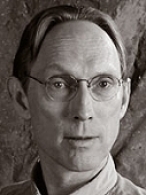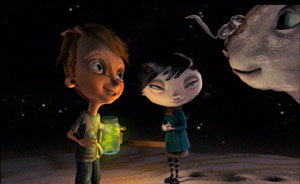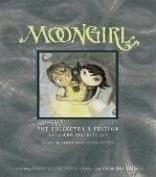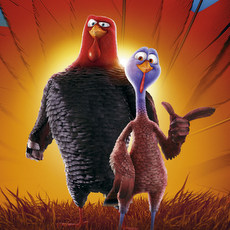 Henry Selick, famed stop-motion director of The Nightmare Before Christmas and James And The Giant Peach, recently took time out of his busy schedule to talk with Animated News & Views about his new short Moongirl and some of his past and future projects. Henry has worked on projects as diverse as Pillsbury Doughboy commercials and the stop-motion sea life effects in The Life Aquatic With Steve Zissou and continues to push the boundaries of stop-motion animation as well as making recent forays into the world of computer animation.
Henry Selick, famed stop-motion director of The Nightmare Before Christmas and James And The Giant Peach, recently took time out of his busy schedule to talk with Animated News & Views about his new short Moongirl and some of his past and future projects. Henry has worked on projects as diverse as Pillsbury Doughboy commercials and the stop-motion sea life effects in The Life Aquatic With Steve Zissou and continues to push the boundaries of stop-motion animation as well as making recent forays into the world of computer animation.
AV: Any thoughts on your time at Disney in the late 1970s/early 80s?
HS: While the studio was stagnating a bit then, I received incredible help in learning to animate and draw and tell stories from Eric Larsen – one of the Nine Old Men – and Glen Keane. It’s where I met Tim Burton, Rick Heinrichs, Jorgen Klubien. I worked with Brad Bird, John Musker, Dan Haskett, Bill and Sue Kroyer, Ed Gombert, Andy Gaskill and a host of other talented folks who have remained friends.
AV: Slow Bob In The Lower Dimensions – still any plans to develop that into a series?
HS: No current plans, I’m afraid, though there are lots of interesting fans of my old short.
AV: Any interesting stories on the Pillsbury Doughboy?
HS: I don’t know his true origins. I know that when I was hired to direct a bunch of Doughboy commercials back in 1989, I received the top-secret Doughboy “kit”, a little suitcase that contained one of the original stop-motion puppet bodies and heads. The body was made of an incredibly toxic material so we made a whole new kit of body and heads. And from the small team of puppet makers, animators, armature makers, etc, I put together to do these spots came the core group of Skellington Studios.
AV: What are your thoughts now on MonkeyBone?
HS: While there are some fans of the film, they are in the minority and the majority of viewers (both public and critics) disliked the film to the point of anger. Now, I do like the idea of shaking up an audience with a subversive comedy. But the price paid in my career has been substantial. Lessons learned are: 1. I need to stay the hell away from live-action and Hollywood; and, 2. Don’t challenge the audience too much unless you’re doing it on a really low budget.
 AV:How did you feel about taking over Vinton Studios, especially coming in after the man himself had been “let go”?
AV:How did you feel about taking over Vinton Studios, especially coming in after the man himself had been “let go”?
HS: The Vinton Studios changed hands before I got here. And, while I feel bad that Will lost his own company, it was not my doing. And I was not hired to become the new Will Vinton — he is an inimitable talent and major contributor to stop-motion animation. Vinton Studios was Will’s company; LAIKA INC. (the new name here) is not my studio. I’m a hired gun, a key creative (but not the key creative) who was hired to direct the short Moongirl and develop features.
AV:How do you feel about CGI, having augmented stop-motion effects with some CGI and now directing a full CG short and upcoming feature?
HS: I found working on my new all-CG short Moongirl very frustrating at times. But that’s because the CG culture and vocabulary and processes took a while to get used to. CG clearly has taken effects in live-action films to places that stop-motion could never really go in terms of worlds created and the seamless blending of so many visual layers.
I’m surprised that, so far, most of the CG animated features all look the same when there’s so much room for visual invention in the medium. I’m really impressed with the two big stop-mo features Curse Of The Were-Rabbit (I loved this film) and Corpse Bride (technically the slickest stop-motion ever done) though sadly disappointed that they haven’t delivered the box office dollars that even mediocre CG features have delivered.
As far as the technique of my new feature, Coraline, well, it could just as well tilt to all-stop-motion versus all-CG or a combo of both. We’re running tests and crunching numbers.
 AV:Can you tell us a little about the origin, the genesis, of Moongirl?
AV:Can you tell us a little about the origin, the genesis, of Moongirl?
HS: There had been a contest at the studio for a short film idea and Mike Berger, a CG modeler here, had come up with the core concept of a girl who operates the moon. His idea was chosen by Phil Knight, and, after pitching my take of what I would do with it, I was hired to direct the short. I spent a while going down blind alleys before I had a script that seemed to work. The main thing I was going for was creating a new myth for kids with an almost Twilight Zone twist at the end, where a bigger story emerges from the parts you’ve seen. The whole lightning-bugs-being-magical element was from my childhood memories of the deep South, where I spent part of my summers as a kid with my mother’s parents and my cousins, aunts and uncles and storytellers.
AV: Was there ever any consideration given to producing it as a stop-motion short, or was it going to be CGI from the outset?
HS: No, it was always going to be CG, the first project to be run through a new CG pipeline that was under construction.
AV: Was its recent screening with The Nightmare Before Christmas the only way it could be seen theatrically?
HS: Howard Green, head of Studio Communications at Disney and an old friend, suggested running the short with the Nightmare Halloween re-release. While a few studios and distributors have expressed interest in Moongirl, decisions have not been made. It’s possible it could premiere on TV or be attached to a nationally-released feature.
AV: Will it ever be available on DVD?
HS: Moongirl, a kid’s book based on the short, will be published by Candlewick Press next year. I wrote the text and Peter Chan and Courtney Booker, two of the key artists on the film, illustrated it. And included in the book will be a DVD of the short.
 AV: Did Joe Ranft have any involvement? If he wasn’t involved with Moongirl do you have any last words about him? I remember you talking about him during the panel discussion.
AV: Did Joe Ranft have any involvement? If he wasn’t involved with Moongirl do you have any last words about him? I remember you talking about him during the panel discussion.
HS: Joe had a tiny bit of involvement near the end of Moongirl. He viewed a work-in-progress copy of the film and gave us a few suggestions. He seemed to like the film a lot. He was the best combination of brilliant storyteller and human I’ve ever known. He was a huge contributor to The Nightmare Before Christmas and James And The Giant Peach and I don’t think Pixar would be where they are without him. He was a sweet giant, level-headed then goofy, wanting to learn more, know more about everyone, drawing out the best in those around him in their work.
AV:Can you tell us a little about Coraline?
HS: Coraline, which I’ve adapted from Neil Gaiman’s novel (meaning I wrote a screenplay based on the book) is in preproduction right now. It’s the story of a not-happy-enough girl, smart and brave but very bored, who discovers a better version of her life through a secret door in the old house she and her parents have just moved into. She meets her “other” mother and father – improved versions of the real ones except they have black button eyes. This other version of her life seems like a kid’s paradise with great food, magical shows, living gardens, etc. But there’s a big price to pay if Coraline wants to stay there.
We currently have started storyboarding and art directing the film and have signed Dakota Fanning to do the lead voice. They Might Be Giants are doing a handful of original songs for us. It’s not clear if it will be CG or stop-motion or a combo of the two at this point. It’s a great project and, working on it here at LAIKA reminds me of early days at Skellington Productions where Nightmare Before Christmas was made.






